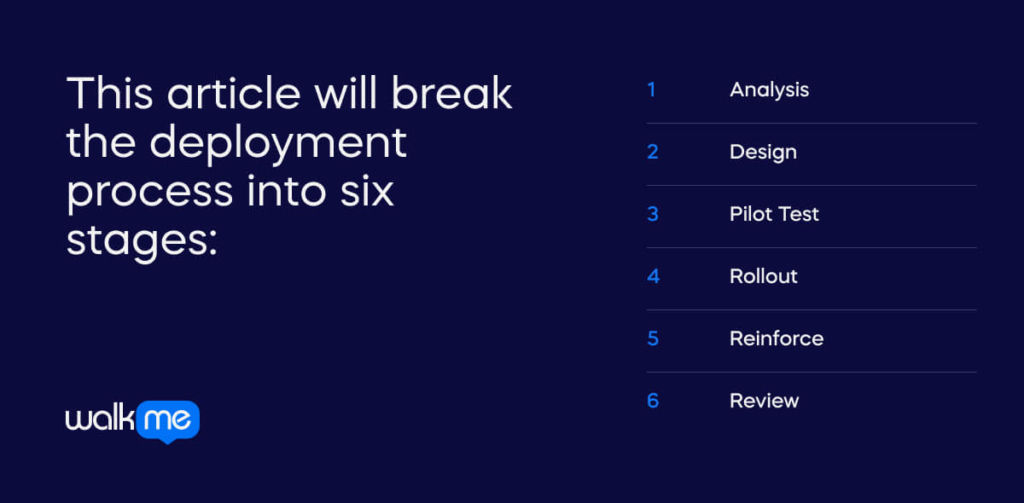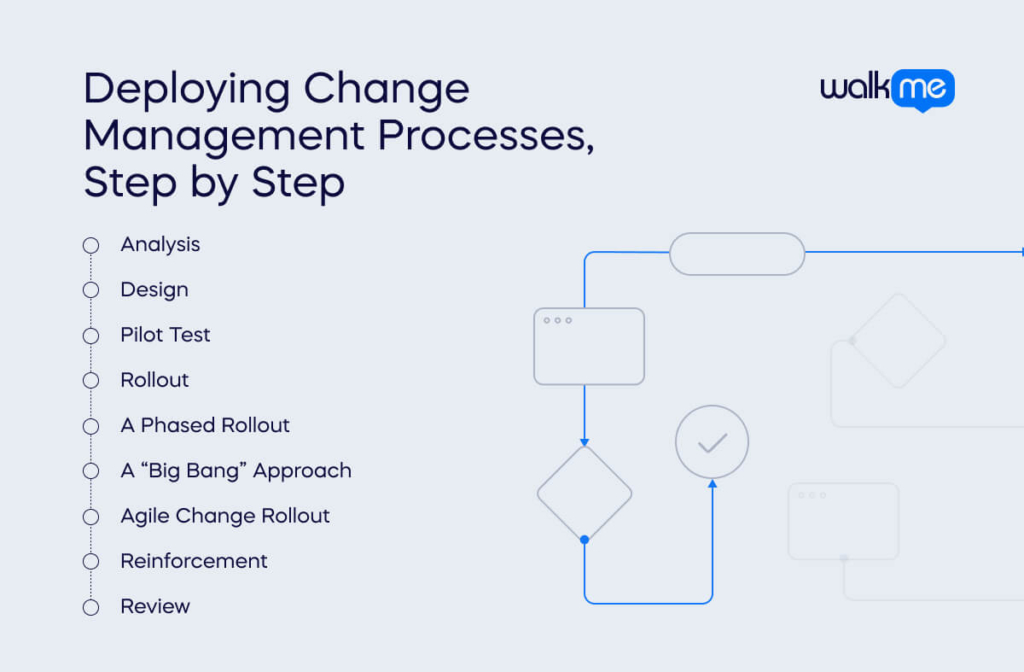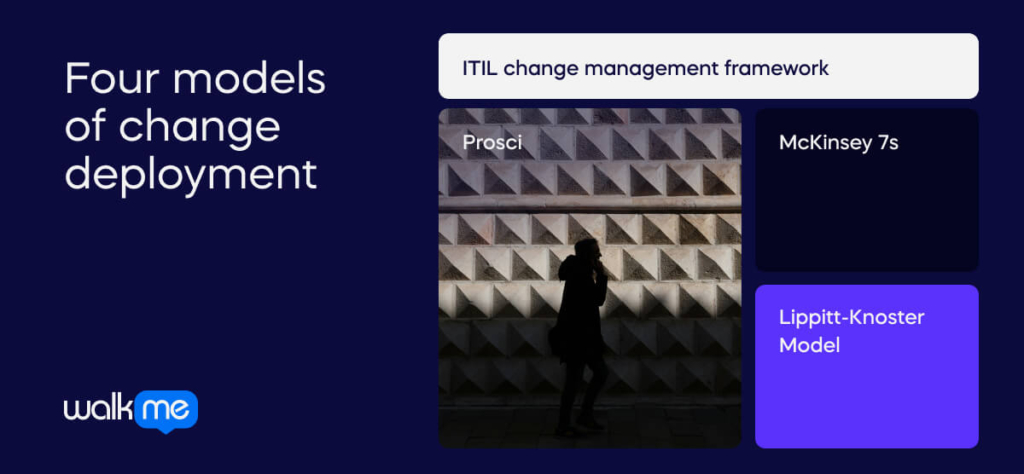When it comes to change management, deployment is everything.
It doesn’t matter if the new process and methods are brilliant. If the organizational practices for change are weak, the change will not lead to the improved business outcomes everyone wants. Worse still, mistakes in the change process can have a negative impact on a business.
Fortunately, businesses in the present can draw on the wisdom and experience from deployment projects over the past decades. And if they don’t have the tools to develop a new approach, leaders can draw on models of deploying change management. There are useful, tried-and-tested techniques out there that anyone can use.
This article will introduce the major stages that any change project must go through.
With the proper change management framework, strategy, and supervision, change management projects can bring outstanding results to a company. Change always involves some risk. But the risk is worth it for the improved growth, sustainability, and value that a powerful culture of change brings.
What is Change Deployment?
“Change deployment” refers to the management practices businesses use to implement a new change in a company.
This may include developing a plan to manage the change, gathering resources, assigning responsibilities, and monitoring progress. It also involves assessing risks, training staff on how to handle the change, and communicating with stakeholders so that they understand the process.
More than anything else, change deployment is a risk management exercise. Through careful attention to the deployment method, organizations ensure the successful implementation of changes while avoiding common pitfalls.
What Are The Main Stages of Deployment?
Different models break down the stages of change management deployment in their own way. Indeed, there are many ways to deploy organizational change effectively, and an organization’s leaders must research their models carefully to ensure that they find the right solution.
This article will break the deployment process into six stages:

- Analysis
- Design
- Pilot Test
- Rollout
- Reinforce
- Review
The first three of these stages deal with planning.
The major step for a change itself is “rollout.”
The final two steps ensure the change is securely embedded within a company culture.
The strange truth of organizational change is that the change itself is only one small part of the process. The change will only be effective if the staff knows how to use a new piece of technology or software. And once a change is in place, a company needs a proper post-implementation review period to be sure that the new approach is working correctly.
Put simply. It can be far too easy for staff to slip back into their old ways or simply not to adapt to the change in the first place.
That’s why everyone needs a step-by-step guide to help them along.
Deploying Change Management Processes, Step by Step

Every change management project has to start somewhere.
That’s why many change models emphasize the different stages and schedules a project must go through before it concludes. ITIL and Prosci are especially good systems for handling the steps in a change process.
However, other systems focus on the overall culture of a company. For example, an analysis with McKinsey’s 7s makes leaders look at how the business works in many different areas.
This section will introduce six crucial steps for change management processes. When relevant, it will indicate connections between these stages and other models of change management.
Analysis
In the analysis stage, change leaders analyze the organization’s processes to see where improvements can be made. Where there is a known problem, the team makes sure that they understand the problem and its causes.
In a major project, the analysis takes place long before the implementation begins.
Some approaches to analysis may focus on the following:
- Employees at all levels are the best source of information about business processes. They will have a deep knowledge of the company’s strengths and weaknesses. Through interviews, surveys, and focus groups, a leadership team can build a picture of the problems that a change could solve. Taking in information from more than one team will create an image of the organization’s overall need to change.
- On the other side of the company, gathering customer feedback is extremely valuable. Long-term customers will know what to expect from the business they work with. They will be happy to share their knowledge when they are approached at the right time.
- Review industry-specific statistics, research, and analysis relevant to the change project. Are there any challenges to the sector as a whole? How are similar companies making efficiencies? If one business has successfully implemented a change, there’s no need to reinvent the wheel.
A holistic understanding of the organization’s problems is critical to developing the right solution. By the end of the analysis stage, a business will have ideas about how its services need to improve.
Design
After the initial analysis, a change team can decide how an intervention can support the company’s business objectives. Those decisions occur in the design phase, where change leaders start to think seriously about how company change will happen.
The change itself is a significant decision. That is the choice of whether the company needs infrastructure changes, new technology, or making staff redundant.
But the design stage also considers how the company will move towards that change. Leaders need to consider whether the staff can implement the change. After all, as a 2021 Gartner guide advises, a poor understanding of people is one of the main reasons that change management initiatives fail.
The change management process must fully view the situation if they want to succeed.
To evaluate the change design, a change advisory board will consider the following criteria:
- Is it beneficial? First, can the solution solve the problem? Quick fixes will not be helpful, nor will any solution that does not positively move the company forward. Change projects can bring significant value across an organization’s processes. If a proposed change brings no obvious advantage, there is no point in continuing with it.
- Is it achievable? Change management has to have the right resources if it is feasible. Does the company have sufficient funding to purchase new technology, give time to staff training, and make it through any risk? Will the current employees be willing to adapt to new ways of doing things?
- Is it sustainable? A change deployment should not blindly follow the latest fad, fashion, or trend. Employees must be able to use the changed systems in every part of their working lives for the duration of the company’s current business objectives.
The design stage allows leadership teams to ensure they are doing the right thing. They have to weigh the benefits against an organization’s current risk tolerance, change management capabilities, and plans for the future.
Good change management models will allow plenty of space for design. For example, in the Prosci 3-phase scheme, design is part of the preparation phase, in which organizations need to understand success, impact, and approach. Change practices following the McKinsey 7 S system address similar concerns under the ‘strategy’ heading.
Pilot Test
A pilot test is the best way to ensure a change strategy is achievable within the workplace. In this stage, end users will engage with the proposed change, providing vital feedback.
In a digital adoption, for example, the company should test new software with a small user group. This user group can provide feedback and usage data.
Data from the pilot test can streamline rollout, improve employee onboarding and training, prevent minor problems from becoming large problems, and Increase program efficiency. On a larger scale, the pilot test shows whether or not a solution will work in the intended way.
No manager should try to implement a solution that cannot succeed fully. The pilot test makes sure that it can. Pilots can take many forms, depending on the industry, and a recent Gartner report shows how different pilots can lead to various business objectives.
Most change management models allow significant time for testing, adaptation, and fine-tuning before a change is properly rolled out. In Prosci methodology, a pilot test will be an early part of the second phase, in which employees are gently taken through the new processes they face.
Rollout
The rollout phase demands more decisions about leadership, timescale, and risk tolerance.
The leadership for a rollout can be taken internally, by product vendors, or by an external consultancy. In a digital transformation project, the vendors may be well-placed to lead on the technical challenges of a new service. If the change is more structural, well-trained internal leaders may be best placed to proceed.
The timeline, of course, depends on the nature of your change program. A software deployment, for example, could take a few weeks to a few months, depending on the scale. The rollout process is a high-risk area where a company faces many competing possibilities.
This section will introduce three models of change rollout: phased, “big bang,” and Agile.
A Phased Rollout
A phased approach deploys solutions one step at a time.
A phased approach could roll out the solution in different ways. It may be by features, which users only use part of the software. Alternatively, by business unit, one part of the company simultaneously gives a serious test. Or by geographical site, in which a branch or branches of the company adopt the package before everyone does.
This type of rollout can synchronize with pilot testing, as in the following order:
- A pilot group tests the software
- The software is deployed company-wide, but users only use certain features
- As users become familiar and comfortable with the software, they transition gradually to the new software
- When a certain level of competency is achieved, the old software is retired
Phasing rollouts gives leaders the time to make adjustments. There’s no turning back once the change has begun, but the risks are minimized.
A “Big Bang” Approach
In contrast, with a “big bang” approach, the deployment takes place all at once.
The whole company switches to a new way of doing things on a given day. This is a very high-risk strategy for organizational change management. A “big bang” counts on an organization’s ability to minimize risk.
Some situations will be more appropriate for an overnight rollout than others. If the company fulfills some of these criteria, a big bang is appropriate:
- The planned change makes a difference in how business units communicate. One part of the company can’t use the old system, while another uses the new one. Everyone has to change to keep operations flowing correctly.
- The business has a clear seasonal pattern of supply and demand. The company can afford to take risks when business is slower – and prepare themselves for the months they have to work flat-out.
- There is some kind of backup system if things go wrong.
A big bang takes confident preparation, training, and research.
Agile Change Rollout
Agile project management principles lead to a different approach to roll out.
With Agile, managers seek to deliver working products quickly, constantly take feedback on the new services, and offer continually improved iterations of the change.
In some situations, this will be impossible. But Agile can offer a great way to reduce risk in a deployment. Agile makes it easier to deal with many critical challenges of change management.
Reinforcement
Deploying change does not end with the rollout. Far from it. Any credible change management deployment system supports the change long after the rollout.
Every company must reinforce its change program to ensure it stays permanent. Factors that can cause backsliding to old patterns of work include:
- Inertia
- Habit
- Fear of change
- Ongoing Employee resistance
- Tradition
- Culture
These problems cannot be underestimated. To reinforce and sustain the change program, it is very wise to:
- Collect feedback from users
- Communicating the benefits of change
- Training and educating
- Analyzing metrics
Keep monitoring your project’s health until it is clear that the change is permanent.
There are also essential questions of leadership in the “reinforcement” phase. When a company uses a change consultant, ownership of the project will be transferred to the hiring company at this stage. The outsourced external change management team may have taken a big role – but now’s the time for internal leaders to take complete control.
Review
A post-implementation review (PIR) is essential for any successful change management project. A review will assess the success of the change and identify areas for improvement. The post-implementation study can include interviews with stakeholders, surveys, and analysis of relevant data to understand how well the project has been implemented. The review will provide critical feedback that will help inform future change management decisions and strategies. Conducting a post-implementation review is beneficial for understanding the success of the current project but can also provide important insight into the effectiveness of change management processes and strategies.
In short, the information from a review can help to:
- Gain insight into your project
- Better understand your company, its culture, its technical capabilities, and its openness to change
- Understand how effective the company’s change capabilities are
- Demonstrate the ROI of the change management project.
It doesn’t matter whether or not the project was a success. A review teaches valuable lessons about the change delivery project.
Four models of change deployment

Many methods of change deployment can take a company through the six steps described in this article. Change leaders do not have to reinvent the wheel when they begin a change project. The wisdom and experience from past practices can bring enormous benefits to a company.
This section will introduce four models of enterprise change management with solid credentials: Prosci, ITIL, McKinsey, and Lippit-Knostler.
- Prosci
Prosci offers change management consultancy, resources, and training. Their ADKAR methodology and the “three phases” process both help provide step-by-step change management practices. In contrast, the PCT model allows one to define success at every stage. Prosci is especially useful for managing the human aspects of a change project.
- ITIL change management framework
The Information Technology Infrastructure Library (ITIL) helps to embed change management in an organization. ITIL gives protocols for classifying different types of technological change through a typology of major, standard, and emergency changes.
ITIL procedures support change projects of all sizes. They operate best when they are properly embedded in a company. As such, ITIL is perfect for any organization that plans to improve its permanent change management capabilities.
- McKinsey 7s
The McKinsey 7s Model is a well-known framework used by consultants and change agents to analyze the various elements of an organization. It comprises seven interrelated components: strategy, structure, systems, shared values, skills, style, and staff. The model states that all these components must be aligned and balanced for organizational change to be successful. This can help managers identify areas that are out of balance and provide the necessary tools for successful change management. By examining each of these components, organizations can clearly understand their current state, create an effective plan for future development and ensure that their strategies are properly implemented.
- Lippitt-Knoster Model
The Lippit-Knoster model of complex change is a collaborative and consultative approach to organizational transformation. It focuses on understanding the organization’s current state, identifying gaps between the current and desired future state, and then creating plans involving all stakeholders to bridge those gaps.
One of the most valuable lessons from the Lippitt-Knoster model is its definition of five essential areas for successful change. These are vision, skills, incentives, resources, and an action plan. A shortfall in any of these leads to problems with the delivery of change.
Thoughts For The Future
Change programs can improve business practices across an organization, in the production environment, Service management, IT infrastructure, staffing, or more. Every change situation requires an excellent change manager who understands all the factors and can deploy an appropriate process for the change and the organization.
There’s no doubt that implementing change management practices is no small task. It takes time, effort, research, and preparation. Experience in change management is always helpful, and some businesses find that consultancies bring a lot of value to their development teams. After all, the cost of not changing can be greater than the cost of inefficient change.
The ROI of change management can be huge, and it’s worth investing time in getting it right.

